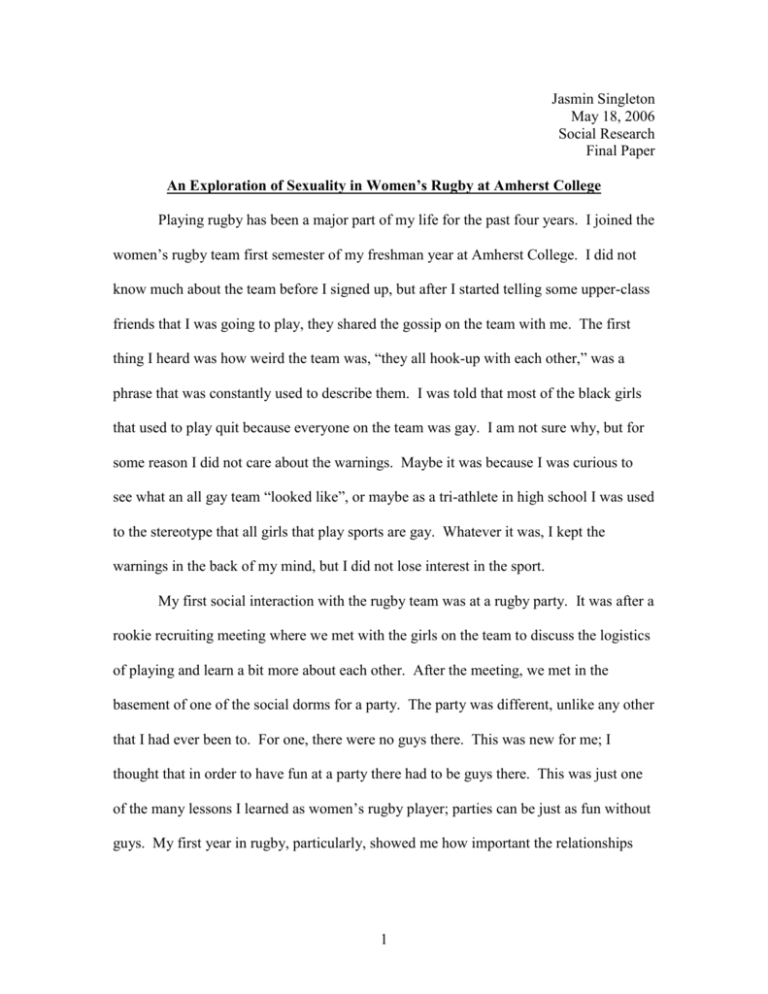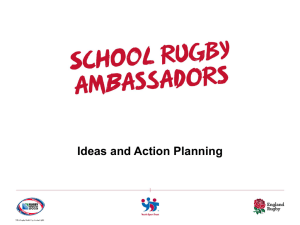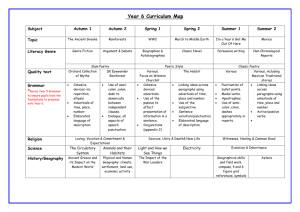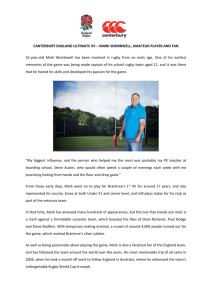
Jasmin Singleton
May 18, 2006
Social Research
Final Paper
An Exploration of Sexuality in Women’s Rugby at Amherst College
Playing rugby has been a major part of my life for the past four years. I joined the
women’s rugby team first semester of my freshman year at Amherst College. I did not
know much about the team before I signed up, but after I started telling some upper-class
friends that I was going to play, they shared the gossip on the team with me. The first
thing I heard was how weird the team was, “they all hook-up with each other,” was a
phrase that was constantly used to describe them. I was told that most of the black girls
that used to play quit because everyone on the team was gay. I am not sure why, but for
some reason I did not care about the warnings. Maybe it was because I was curious to
see what an all gay team “looked like”, or maybe as a tri-athlete in high school I was used
to the stereotype that all girls that play sports are gay. Whatever it was, I kept the
warnings in the back of my mind, but I did not lose interest in the sport.
My first social interaction with the rugby team was at a rugby party. It was after a
rookie recruiting meeting where we met with the girls on the team to discuss the logistics
of playing and learn a bit more about each other. After the meeting, we met in the
basement of one of the social dorms for a party. The party was different, unlike any other
that I had ever been to. For one, there were no guys there. This was new for me; I
thought that in order to have fun at a party there had to be guys there. This was just one
of the many lessons I learned as women’s rugby player; parties can be just as fun without
guys. My first year in rugby, particularly, showed me how important the relationships
1
are that females have with each other. One of the girls I interviewed described it
perfectly, she said,
I think that the essence of how rugby is played creates a camaraderie that may not exist on other
teams. I’m willing to take a hit because I believe that one of my teammates will be there to make
something of the play. I try as hard as I can to be there in support so that my teammate isn’t left
alone against (potentially) several other girls from another team. And when a try is scored it is
usually from the effort of the entire team and not just a single person. Maybe the dependence on
one another for success creates an admiration that mixed with alcohol leads to attraction for some
girls.
Rugby brings women together, both on the field and in the social settings. I do not mean
that just the platonic, or just the sexual relationships that girls have are important, each
add significant meaning to the team atmosphere. Because the social scene of rugby plays
such a large part in the players social experience at College, I thought I would examine
the social culture of rugby. In particular, I wanted to look at the sexual culture of rugby
and whether or not women join the team because of the connection of the sport to
homosexuality or if due to the culture of the sport, girls tend to experiment in homosexual
or bisexual activities. What I have found is that there is much more to the social and
sexual scene of rugby than just this question. I have found that the public nature of
sexuality on the team is also an important piece to understanding whether or not girls
change after playing the sport.
History
Rugby is often compared to American football, but in many ways the sports are
polar opposites. In rugby there are no pads, and no helmets. The only protection that
everyone on the rugby pitch must have is a mouth guard, though some people do wear
shoulder pads and scrum caps. The rugby ball is also different from the American
football in that it is rounder and more oval than a football. Rugby was first played on
2
American soil in 1874, when Harvard played McGill University of Canada. Rugby’s
popularity in America grew when it was introduced in the Olympics in the early 20th
century. However, shortly after the 1924 Olympics, it was decided that rugby would no
longer be an Olympic sport and American interest died down. American attention to the
sport began to grow again in the 1960’s and 1970’s and USA Rugby, the United States of
America Rugby Football Union, was formed in 1975.1
Rugby is now played in over 100 countries on 5 continents, by men and women of
all ages; but most men and women in the United States are not introduced to the sport
until they reach college.2 Rugby teams are usually not varsity at collegiate level, but
instead are club teams. There are some advantages and disadvantages to this
arrangement, but for the most part, rugby is a club sport because of the lack of popularity
of the sport on a national level. Some of the advantages of having rugby as a club sport
are that the team gets to choose the way it is run, elect its own officials and coaches, and
control the way the team’s money is spent. Some of the disadvantages are the lack of
funding, respect and overall notoriety from the university. Rugby players, unlike most
division 1 varsity sports, are usually not on scholarship. In fact, very few universities
offer scholarships for rugby at all. This, however, does not deter men and women from
putting their bodies in harms way every time they step on the rugby pitch. In fact, the
camaraderie that surrounds the sport has a great deal to do with the close knit
relationships that women (as well as men) ruggers develop with each other.
These relationships have at times developed from friendships into sexual
relationships. There is currently a stigma attached to women’s rugby, particularly in the
1
2
“An American Tradition,” USA Rugby, 2002, <http://www.usarugby.org/about/history.html>.
“The International Rugby Board,” IRB, 2002, <http://www.irb.com/About/>.
3
United States, that all women that play are gay. Though women’s rugby is considered a
gay sport in the United States, this is definitely not true across the world. In fact, last
spring while I studied abroad in New Zealand, the world’s capital of rugby, I noticed that
most of the women I played with were married or had boyfriends. When the topic of
homosexuality came up, I was told that it was an American thing (most of the
homosexual girls on our team were American) and that rugby is really not like that.
After my experience in New Zealand, it was clear to me that homosexuality is not innate
in women’s rugby; rather that homosexuality has been attached to women’s rugby in
America through the transmission of negative stereotypes.
One reason that it is acceptable for women’s rugby to be associated with
homosexuality as opposed to other collegiate and professional women’s sports in the
United States is because rugby is not highly publicized here. Rugby is not visible; the
games are not on national television. In a sense, a case can be made that is okay for
women to be gay/bisexual in a sport, or in general, as long as it is not visible, or talked
about. For instance, in other professional or collegiate sports, homosexuality is not
accepted. If we look at the WNBA in particular, there is a large fan base in the
gay/lesbian community and there is “imagined” communities of women that play
basketball that are homosexual, however, very few players in the league are publicly out
about their sexuality. Clearly this is not the case with women’s rugby as many players
are publicly out about their sexuality and the sport seems to accept it.
As I mentioned earlier, rugby is a very physical sport, more physical than women
are expected to be and while it seems acceptable for men to engage in this type of sport,
the same is not true for women. Women are expected to be soft, sweet and charming, not
4
muscular, tough and aggressive. I always get a questioning look when I tell people I play
rugby. For the people that know what the sport is, their eyes bulge out as they look me
up and down as if I do not fit the image of what a women’s rugby player looks like.
When I asked the ladies I interviewed what the stereotypes of women’s rugby players
were, they listed: rowdy, heavy drinkers, gay/bi-sexual, intimidating, tough, and overly
sexual. In some cases these stereotypes are true; some female rugby players are rowdy,
heavy drinkers or gay, however, this is not true for all women rugby players. The
problem that many female rugby players face is that because they are apart of a sport that
is so heavily associated with homosexuality, it is sometimes hard to separate players that
play because they love the sport and others that play because they are gay. Through
interviews, I hope to come to terms with these issues.
Sampling
The Amherst College Women’s Rugby team is a diverse group of twenty-five
(25) girls. For this project, I interviewed ten (10) of the twenty-five girls. Each girl
comes from different racial, ethnic and economic backgrounds. None of the girls
interviewed played rugby before arriving at Amherst College and all of the girls played
for at least one semester, with 8 semesters being the most that any of the girls played.
The racial backgrounds of the girls were diverse, three (3) of them were of African
American descent, two (2) were Asian, and five (5) were white. The girls also came from
different parts of the country, including the west coast, mid-west, south and north-east.
Half of the girls (5) considered themselves gay or bisexual and the other half straight (5).
Before beginning my interviews, I did some research on my topic to see what
other authors and sociologist had written. What I found was that there is very little to
5
nothing on the topic of homosexuality in women’s rugby and what is written is written by
women’s rugby players themselves. I found no studies by sociologists that talked about
similar topics. The closest study I have read is by Richard Pringle and studies the
formation of masculinity in men’s rugby in New Zealand. This article had some good
insight, but did not offer much for my own research. Before beginning my interviews,
most of the information I had came from my personal experiences playing rugby and
some short articles I read by women ruggers about rugby in general and not specifically
about the topic of homosexuality.
To get girls to sign up for my project, I sent out an email to everyone on the rugby
team. Within the first few hours after I sent out the email, six girls responded that they
wanted to be interviewed. In the next few days, I received more emails expressing
interest in my topic and asking for more information about the project. By the time I
began interviewing, I had 12 people lined up for interviews. Initially, I had a total of
fourteen (14) girls that wanted to be interviewed, but two of the people had less than one
(1) semester of experience with the team. I told these two girls that I was interested in
people with at least one semester of experience with the team. Of the twelve girls that
remained, two were unable to schedule interviews and were not interviewed.
The first interview I conducted took place over the phone. All of the rest of my
interviews, except one which was over the phone as well, were face to face. These
interviews were given either in the person’s room or in the campus center. I started off
each interview by reading a brief synopsis of what my research entailed. The following
is the passage I read to each interviewee:
The purpose of my research is to evaluate the sexual tendencies among women who play rugby to
see whether it is more likely for women that are already gay/bisexual to join the sport, or if women
6
tend to engage in bisexual/gay activities due to the culture of the sport (after joining). In order to
do this, I will be asking you some questions about your personal experiences and knowledge about
the sexual culture of women’s rugby at Amherst College. I will start by asking some brief
questions about your sexual history before rugby. Please feel free to answer in as much or as little
detail as you feel appropriate. All of the information shared in this interview will be confidential.
After reading this passage, I began asking questions off of the list I brought with me. I
jotted down notes while the people talked with me. I tried to maintain eye contact during
the interviews, though this was sometimes hard. I did notice that my writing often
grabbed the attention of the person being interviewed. They would focus on what I was
writing, rather than their answer to the questions I asked. I tried to combat this by not
writing as much, but this also posed a problem because I did not tape record any
interviews. In the end, I found that for the girls that had a great deal to say, my writing
did not bother them much and the girls that gave shorter answers were more likely to stop
when I began to write.
During the interviews, the girls spoke freely for the most part, though I did find
that the seniors had much more to say about everything than the younger players did.
This may have been because I have played with these girls longer and they are more
comfortable with talking to me or because they have played longer and have more to say.
In any case, the interviews with the seniors tended to be longer and a lot more detailed.
Overall, each interview lasted between 15 and 35 minutes.
The questions I asked during my interviews are:
1.
2.
3.
4.
How long have you been playing rugby?
Why did you join the team?
What did you hear about the sport or team before you joined?
How would you describe the sexual culture of women’s rugby at Amherst
College?
5. What was your sexual preference before joining the team?
6. Has your sexual identity changed since joining the team?
7
7. Do you believe there are certain sexual stereotypes attached women’s rugby?
What are some?
8. How did you feel about joining a team that had these characteristics attached
to it?
9. Are there any expectations attached to the notion of what it takes to be a rugby
girl?
10. Does women’s rugby attract gay women or do women tend to engage in gay
or bisexual activities due to the culture of the sport?
While these questions outlined what would be addressed during the interviews, they did
not limit what we discussed. For many of the girls, the interview was one of the first
chances they had to discuss how they actually felt about the rugby team and they were
eager to share their opinions with me. Initially, I thought my sampling was representative
of the team because of the diversity within the girls that were interviewed; however, I
now see that this could also be limiting because as with most situations where people are
being asked to respond to a researcher, only the people that are interested in speaking
respond to be interviewed. This excludes the 14-15 opinions that did not want to be
interviewed or did not have the time to schedule with me. In any case, the sampling
represents the general opinions of the women’s rugby team from a variety of
perspectives, seniors, freshmen, lesbians, straight women, black women, etc. I do believe
that if I would have had more time, it would have been interesting to see what all of the
girls said, including the new girls that have only played for a semester or less. It would
have been interesting to hear their initial opinions on the culture of the team. By the time
I completed my interviews, I felt as though I had a good sampling of people and solid
data to work with.
Discussion
Why do people join the team?
8
One of the first questions I asked during my interviews was why did you join the
rugby team? What I found is that people join rugby for a variety of reasons and not just
because they want to be apart of a gay team. When I came into this project I came with
the basic question, does rugby attract a particular kind of person, or does the culture of
the sport change the person. My assumption at first was that it was a bit of both. Rugby
does attract a certain kind of girl, not necessarily gay, and that rugby also changes people,
though mostly in subtle way.
From the interviews I conducted, the individual reasons girls joined the team were
varied; some joined because they wanted to be close to friends that played, some wanted
to meet new people and others wanted to be apart of a “gay” team. Two out of the ten
girls (twenty percent) said they joined because of the association of the sport with
homosexuality. This seems like a very small percentage considering the common
perception that women’s rugby is a gay sport. It is clear from this data that sexuality, in
particular homosexuality, was not as big of an influence on girl’s joining the team as one
might expect. Out of the two girls that said they did join because of the connection, one
girl said that she knew she would join when over the summer, she saw a crossover
between dykes and dates (a party for QGBTA people) and women’s rugby while looking
at various students’ Facebook page. The other girl said that her interest was sparked
when she watched one of the collegiate teams in her city play and learned of the
reputation and association of the sport with homosexuality. Both ladies said they joined
because they believed the rugby atmosphere would be comfortable and welcoming to
them as lesbian and bisexual girls. One other rugger also discussed the idea of women’s
9
rugby players being role-models for girls who are questioning their sexuality. While this
rugby woman did not join the team for the reasons the other two did, she spoke of how
having lesbian leaders on the team helped create an atmosphere that made it okay and
even attractive to be homosexual.
Culture
Before I discuss how the culture of rugby influences people on the team, I must
first describe what the culture of rugby is at Amherst. It is sometimes hard to pin down
the culture of a particular group of people, particularly when the members come from
different cultures prior to joining together as is the case of rugby at Amherst. I will start
off by describing some of the similar beliefs and behaviors that the girls on the team
share in hopes of conveying the deeper meaning of what it really means to be a women’s
rugby player at Amherst College. One of the most common beliefs I found that both
outsiders and AC women rugby players have about themselves is that they are tough. As
one girl I interviewed said, “Rugby women don’t take shit!” Much of the way the
Amherst rugby girls interact with the public and each other has to do with this idea of
toughness. On the field, everything from taking a tackle to breaking through tackles has
to deal with how tough and aggressive a player is. But, what does it mean that rugby
women don’t take shit. The same girls went on to say, “Heterosexual women take shit…
Rugby women are not submissive, and men are less likely to want to be with women like
that.” Here, this rugger has gone from the idea that rugby women do not take shit to
homosexual women do not take shit. This is interesting because, while I do think she
meant that rugby women do not take shit, I am unsure of her implications of homosexual
10
women do not take shit. At the same time, by implying this it is also implied that to
rugby women are homosexual. I do not believe that this rugger meant to say this though.
One reason this idea of toughness is so important is because it is a characteristic that is
usually not associated with femininity, just as rugby, like most sports, does not conform
to the ideals of what it means to be a woman. To be tough and to play rugby, one must
be a particular type of woman and most people automatically believe this is not a straight
woman.
Another rugger explained a similar feeling. She talked about feeling less
attractive to men as a woman that plays a sport that is so rough. She said, “As someone
who dates men, I don’t want people to think that I don’t like men, because I do, but then
again, it’s not that big of a deal.” This idea of not being attractive to the opposite sex was
a concern for a few of the heterosexual women I interviewed. The type of woman that
plays rugby is aggressive, sexually liberated, open-minded and athletic. But for many
men, the idea of a rugby woman does not fit with the ideal of what a woman should look
like. A tough woman is not an attractive woman. While this is statement is clearly false,
as many of the women that play rugby at Amherst are very attractive and have mates of
the opposite sex, there does appear to be some opposition between what the picture of a
rugby woman is, tough, aggressive, etc. and what a woman or an attractive woman should
be.
A rugby woman is a particular type of woman and she is believed to be openminded and accepting of sexual difference. A female rugger would never criticize or
ostracize another rugger for being homosexual or bisexual. However, as one player
described, the team can be less accepting of people that have not declared a sexual
11
identity. In other words, you can be any sexual persuasion you want while on the team,
but you must be something, and you must make it known. One explanation for this
reaction towards sexual ambiguity was explained by another rugby player I interviewed,
she said, “Everything is so sexual.” What she went on to describe was an atmosphere that
incorporated sexuality in everyway, whether it was from talking about the past weekend’s
hook-ups to making jokes about couples on the team. With the constant interplay of
sexuality, it is understandable why it is so hard to accept a sexually ambiguous person.
However, despite the pressure to define yourself in some way, it was clear from all the
interviews, that the team environment supports sexual freedom.
As I mentioned earlier, I was unsure how I would describe what the culture of
rugby incorporates. Rugby culture at AC is open and it involves women from all races,
regions and sexualities. But while the culture of rugby at AC has its own characteristics,
there is also a notion of a universal culture of women’s rugby in the United States, or a
“global family” as one AC rugger described it. What is meant by a global family she
went on to describe, she said, “no matter where you go it’s the same, you go into a bar
and say you play rugby they buy you a beer, you meet up with other teams and you sing
the same songs. The traditions are similar.” Knowing this, it was very difficult for me to
differentiate what the culture of rugby is from what the culture of rugby is at Amherst
College. What I have found is that while there are some universal truths about women’s
rugby, such as a culture built on drinking and tradition, there is a distinct culture of rugby
at Amherst that is not necessarily representative of rugby as a whole. One place where
the culture of rugby at Amherst College is transmitted and reaffirmed is at rugby parties.
12
It is safe to say that parties are a huge part of the social culture of rugby. They
include drinking, singing songs and hooking up with guys and girls, all of which foster
the relationships that teammates have. For many girls, rugby parties shape their
experience as ruggers. For outsiders, rugby parties confirm the stereotypes that ruggers
are heavy drinkers, obnoxious and engage in random hook-ups. Some of the girls I
interviewed talked about rugby parties as either influencing their decision to play rugby
or turning them off from the sport. For these women, their like or dislike of the party
scene did not turn them from the sport, as all of them continued to play, but helped form
their relationships with other girls and also affirmed their identity as a particular type of
rugby player. What I mean by a particular type of women’s rugby player is that for girls
that want to drink, they came and had a good time, but for girls that did not drink or
hook-up with guys/girls they also came to the parties, but had different experiences of the
party scene.
Rugby definitely opened my eyes up to new things. For one, sex and sexuality
were topics that were inescapable both at parties and on the rugby pitch. One rugby
tradition, for example, is that one Fridays, during the girl’s and boy’s training session,
there is a court session. During court session, all of the hook-ups that have occurred
during the past weekend’s party, either between guys and girls or girls and other girls are
announced to the entire team, and the guy or girl that the rugger has hooked-up with must
run a lap around the team’s circle. While this tradition may be a bit intrusive on the
personal lives of the rugby players, everyone knows that if they hook-up with someone
the team will find out. Everyone knows that their behaviors at parties are on display.
This was something new for me as well as some of the other girls on the team; sexuality
13
was an issue of discussion. In most settings, it is always assumed, unless otherwise
stated, that everyone is straight. This was another lesson that many girls learned during
rugby, never assume anyone is straight. In fact, it might be the opposite; everyone is
assumed to be gay. During our court sessions, it was quite often that we found out for the
first time that someone had hooked-up with a girl.
The party scene let everyone know who was what. The girls that hooked up with
other girls were considered gay or bi and the girls that had boyfriends or hooked up with
guys from the men’s team were straight. The girl’s that had a more ambiguous sexual
identity, either because they did not hook up with anyone at parties or because they never
talked about a boyfriend were subscribed a sexual identity. For Princess, one of her first
interactions with the women’s rugby social scene came from the seniors questioning her
sexuality. They not only questioned her sexuality, they told her she was gay. Princess
spoke of how uncomfortable the situation made her and that she was unsure if she would
continue to play. The identity that the seniors assigned to Princess did not fit with how
she identified herself. This caused problems and annoyed Princess. She questioned why
she had to prove that she was straight.
Princess’ story is so interesting to me because it shows the connection between
what most of the girls I interviewed, including Princess, called the accepting environment
or open space of rugby and Princess’ experience. Most of the girls I interviewed spoke of
rugby as being an open space to express your sexuality however you please. However, it
is clear from Princess’ experience that everyone did not feel that way, she said, “It’s great
that there is a sport where you can be comfortable with being gay, but it is also
intimidating for people who are straight and want to play rugby.” For people that are
14
straight, they can sometimes feel that they are bombarded with this idea that everyone
who plays rugby must want to experiment with girls. Princess felt that the seniors
thought they could turn her gay, she said, “This was a disappointing realization… I felt
like I couldn’t really be myself.”
For Jamie, another senior on the rugby team, she also felt the pressure from
seniors expecting her to hook up with other girls on the team. She says, “It changes from
year to year, but there was a lot of pressure to hook-up with other girls from seniors.” It is
interesting to note that Princess’ and Jamie’s discussion of the pressures or expectations
expressed to them were from the times when they were freshmen and sophomores.
However, there was also the feeling that as seniors graduated or left the team, the
atmosphere and expectations of team members changed. For instance, Princess spoke of
the changing image of incoming rugby players, she says, “People now want to play the
sport, as opposed to being scared into playing.” This goes along with the idea that
women rugby players are intimidating. It seems that while this may be a stereotype of
women’s rugby from outside, the actual inside factors vary from year to year depending
on the upper-class members of the team.
While parties are used as a way of maintaining the status-quo within the team,
meaning that parties are an arena where the expectations of the seniors or leaders of the
team are expressed, they are also a space where people can affirm their identity separate
from team expectations. For instance, one girl explained her reaction to the party scene,
she said, “I thought it was a bit much at the beginning (describing the party scene); I
didn’t understand why girls introduced themselves by their sexuality. I thought the girls
did it to test me, but I didn’t feel like I had to be a certain way to play.” This girl
15
described the atmosphere of parties as placing pressure on people to display their
sexuality. She went on to say that she did not feel like she was expected to be a particular
way, as in gay, straight or in the middle, but there was definitely pressure to be sexual,
whether it was in the way people talked with each other or how the stereotypes of what a
rugby girls is gets projected onto the way girls on the team act (i.e. Rugby girls are
sexually liberated).
It is clear from all of the stories I have shared that the one trend that pervades
everyone’s experience of rugby is that sexuality is public. This is shown in the way
rugby girls interact with each other as well as the way outsiders view rugby. Sexuality is
public in every sphere, parties, on the field, expectations held by seniors, and the way
rugby women carry themselves. It is therefore understandable that when one thinks about
women’s rugby at Amherst, sexuality is inextricably linked. Whether it is the idea that
women that play rugby are gay or that women that play rugby are sexually liberated, the
sexual nature of the team is a primary characteristic of the culture of the team. Sexuality
and women’s rugby at Amherst College can not be separated. While it is clear from my
interviews that sexuality, or homosexuality, was not a large influence for most girls to
join the team, it is apparent that public of nature of sexuality within team shapes each
persons experience while on the team.
Women’s Rugby: Liberating or Oppressive?
One important question that came out of my analysis of the social scene of
women’s rugby is: do girls find the sexual culture of rugby liberating or oppressive? This
is an important question because while most of the girls described rugby as an open arena
for sexual expression, many described situations where they were pressured to fulfill
16
certain expectations by the leaders of the team. This was particularly expressed in
Princess’ story, but also in Jewel’s story. Jewel described a situation that occurred when
she was a freshman where one of the senior leaders on the team wanted to make out with
her. Jewel knew that she was not gay, but at the same time she felt pressured to
experiment. This pressure was stated by other girls on the team; they felt that whether
they engaged in it or not, there was always a lingering feeling that they should hook up
with another girl. This feeling was mostly asserted by the seniors and juniors of how
they felt when they freshman and sophomores. I also got the impression that most of
them felt that in some ways this expectation was no longer there because many of the
girls where the pressure came from graduated.
Finally, getting back to the question, do girls find the sexual culture of rugby
liberating or oppressive; I think it can be a bit of both. Above I listed some examples
where the culture can really be oppressive. However, at the same time, there are many
more examples of how liberating the culture is. For instance, most girls love the fact that
they can be out about their sexuality in an atmosphere that respects and understands the
fact that everyone is not heterosexual. Rugby provides this atmosphere. In many ways,
girls are not punished for being experimental or sexually “free” (or permissive as some
might call it) as they might be in other environments. There was also an idea of how
many of the girls changed during their time with rugby. Many girls spoke of how fluid
sexuality became for them after their time in rugby. Personally, this was one of my most
interesting findings of all my data.
What I found was that the mindset of many of the girls changed after being apart
of the team. Particularly when thinking about sexuality and sexual behavior, many
17
people I interviewed felt they had, in some way, changed after playing rugby. I do not
mean that people came into the sport straight and left gay, but rather rugby influenced the
way they perceived sex and sexuality. For instance, many of the girls originally believed
that sexuality was a static concept, but after playing rugby this changed. They now felt
that sexuality was fluid; people do not have to be either straight, gay or somewhere in the
middle. For them, the gray area of sexuality is where most people are.
One girl I interviewed described sexuality as a continuum. She spoke of herself
as believing that she was straight, but at the same time not being able to consider herself
totally straight, she said, “ I would never say that I am 100 percent straight and getting
comfortable with this idea was hard.” This feeling was commonplace for many straight
girls on the team. Another girl I interviewed described a similar feeling of not believing
that she, or anyone else, was 100 percent straight. She went on to say that while it was
more likely that she was attracted to guys, she does not see it as a closed decision, or as
closed as it used to be (meaning before rugby.)
I was shocked by how freely the girls spoke of their transformed opinions of
sexuality. Particularly, the girls that once considered themselves straight, to say that
there is room for doubt is a large step that most people will not take. Personally, I was
somewhat hesitant when writing this section and revealing some of my own insecurities
about sexuality. Before rugby, much like other girls on my team, I would have never
questioned or thought about sexuality as something other than the binary. However,
rugby forced me to explore the possibility that everyone does not fit into a category. This
realization, that many girls come to, has a great deal to do with the culture of the sport
and how it influences the players that partake in it.
18
Conclusion
This research project has been both an awakening and frustrating experience. At
times it was difficult for me to separate my own personal opinions and experiences from
what I was expected to do as a researcher. However, after fighting with my ego that told
me I knew everything about women’s rugby, I stepped back and learned a great deal from
the ladies I interviewed. The first major point that came out of my research was that girls
join rugby for a variety of reasons, many of which I have mentioned above, and most do
not join because they want to be apart of a gay team. The second thing I found was that
sex and sexuality are big parts of the culture of rugby. In particular, the idea that
sexuality is everywhere and must be public was a huge theme that continued to surface
throughout my interviews. Thirdly, I found that there is a huge team impact on sexuality,
in the sense that team members come to see as sexuality as fluid. This was the most
interesting find for me because, while I do think sexuality is fluid, I never thought of
rugby as an influence until I spoke with the other girls on the team. By the end of my
research and analysis, I have come to a different understanding of the sexual culture of
women’s rugby and how it affects the members of the team.
19






